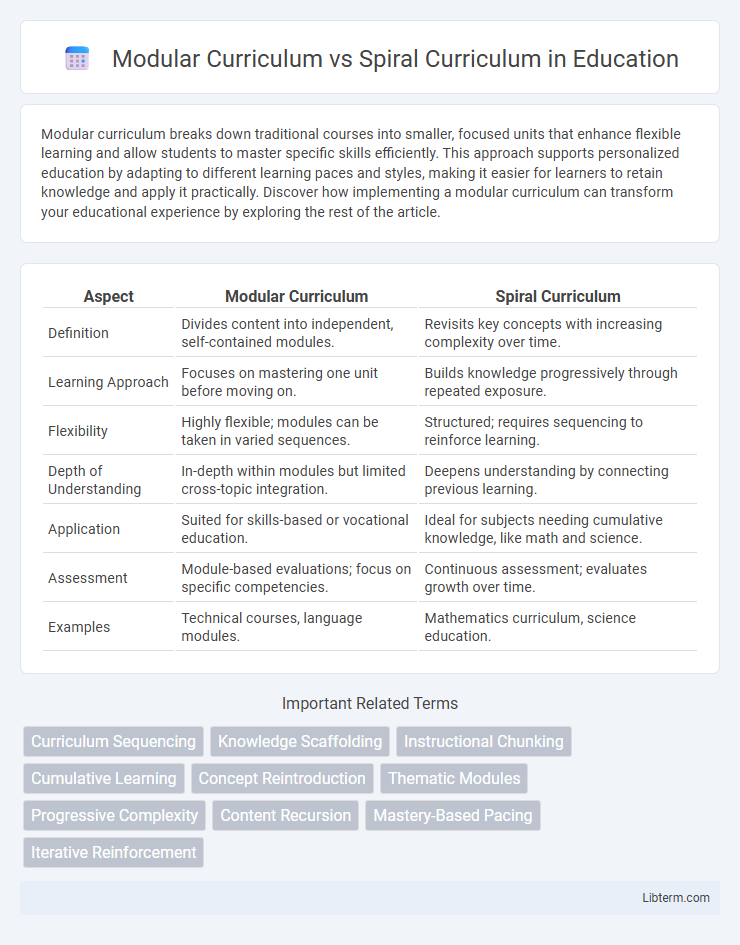Modular curriculum breaks down traditional courses into smaller, focused units that enhance flexible learning and allow students to master specific skills efficiently. This approach supports personalized education by adapting to different learning paces and styles, making it easier for learners to retain knowledge and apply it practically. Discover how implementing a modular curriculum can transform your educational experience by exploring the rest of the article.
Table of Comparison
| Aspect | Modular Curriculum | Spiral Curriculum |
|---|---|---|
| Definition | Divides content into independent, self-contained modules. | Revisits key concepts with increasing complexity over time. |
| Learning Approach | Focuses on mastering one unit before moving on. | Builds knowledge progressively through repeated exposure. |
| Flexibility | Highly flexible; modules can be taken in varied sequences. | Structured; requires sequencing to reinforce learning. |
| Depth of Understanding | In-depth within modules but limited cross-topic integration. | Deepens understanding by connecting previous learning. |
| Application | Suited for skills-based or vocational education. | Ideal for subjects needing cumulative knowledge, like math and science. |
| Assessment | Module-based evaluations; focus on specific competencies. | Continuous assessment; evaluates growth over time. |
| Examples | Technical courses, language modules. | Mathematics curriculum, science education. |
Introduction to Curriculum Design Approaches
Modular curriculum structures content into independent, self-contained units allowing flexible learning paths tailored to individual needs, enhancing mastery through focused topics. Spiral curriculum revisits core concepts at increasing complexity levels over time, reinforcing knowledge and promoting deep understanding through repeated exposure. Both approaches optimize curriculum design by addressing different learner engagement strategies and cognitive development stages.
Defining Modular Curriculum
Modular curriculum is an educational design that divides content into independent, self-contained units or modules, allowing personalized pacing and focused mastery of specific topics. This approach prioritizes flexibility and modularity, enabling learners to progress according to individual needs and preferences while facilitating easier updates and curriculum customization. Distinct from spiral curriculum, which revisits topics cyclically, modular curriculum emphasizes discrete, isolated learning components optimized for targeted skill development.
Understanding Spiral Curriculum
The Spiral Curriculum emphasizes revisiting core concepts at increasing levels of complexity, facilitating deeper understanding and long-term retention. Unlike Modular Curriculum, which separates topics into discrete units, the Spiral approach integrates previous knowledge with new material, reinforcing learning through continuous connection. This method supports cognitive development by building on prior knowledge and promoting mastery over time.
Key Differences Between Modular and Spiral Curriculum
Modular curriculum organizes content into independent, self-contained units, allowing students to master specific topics before moving on, whereas spiral curriculum revisits topics repeatedly with increasing complexity over time. Modular curriculum emphasizes flexibility and targeted learning outcomes, while spiral curriculum promotes cumulative understanding and reinforcement of concepts. Assessment in modular curriculum is often unit-based, contrasting with the continuous, integrative assessment approach of spiral curriculum.
Advantages of Modular Curriculum
Modular curriculum offers flexibility by breaking down content into independent, manageable units that allow learners to progress at their own pace, enhancing personalized learning experiences. It facilitates targeted skill development and easier assessment, enabling educators to adapt content quickly to meet diverse learner needs or industry demands. Unlike spiral curriculum, modular design supports just-in-time learning and modular certification, improving both learner motivation and practical application.
Benefits of Spiral Curriculum
Spiral Curriculum reinforces learning by revisiting key concepts at increasing levels of complexity, enhancing long-term retention and deeper understanding. This approach aligns with cognitive development stages, allowing students to build on prior knowledge systematically, which boosts mastery and confidence. Frequent review and integration of topics in a Spiral Curriculum promote critical thinking and application skills across diverse subjects.
Challenges in Implementing Modular Curriculum
Implementing a modular curriculum faces challenges such as ensuring consistency across modules, maintaining coherent progression in students' learning, and managing resource allocation for diverse, self-contained units. Teachers often require specialized training to facilitate modular instruction effectively, and assessment methods must adapt to evaluate discrete competencies rather than continuous development. Institutional coordination is critical to prevent overlaps or gaps in content, demanding robust curriculum design and administrative oversight.
Limitations of Spiral Curriculum
The Spiral Curriculum, while promoting revisiting topics with increasing complexity, often struggles with student retention due to its fragmented approach that can cause confusion and redundancy. It may limit deep mastery of subjects as learners encounter concepts multiple times without fully consolidating previous knowledge. This curriculum model can also pose challenges for teachers in pacing and integrating content effectively across grade levels.
Choosing the Right Curriculum for Your Educational Needs
Selecting the right curriculum depends on learning objectives and student adaptability, as modular curricula offer flexibility through self-contained units that can be personalized to individual pacing and interests. Spiral curricula reinforce understanding by revisiting topics repeatedly at increasing levels of complexity, ideal for subjects requiring mastery over time, such as math and science. Assessing factors like subject matter, learner engagement, and skill retention guides educators in choosing between the adaptive, segmented approach of modular design and the iterative, cumulative progression of spiral curriculum.
Future Trends in Curriculum Development
Future trends in curriculum development emphasize the integration of modular curriculum for personalized learning paths alongside spiral curriculum to reinforce key concepts through iterative exposure, enhancing knowledge retention. Advances in educational technology enable adaptive learning platforms that support modular flexibility and cyclical revisiting of content, responding to diverse learner needs and rapid knowledge evolution. Emphasizing competency-based education, curriculum designs are shifting towards blending modular units with spiral revisitation to balance depth and progressive complexity in skill acquisition.
Modular Curriculum Infographic

 libterm.com
libterm.com